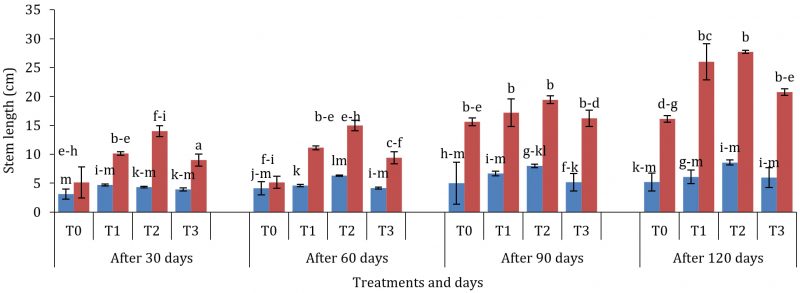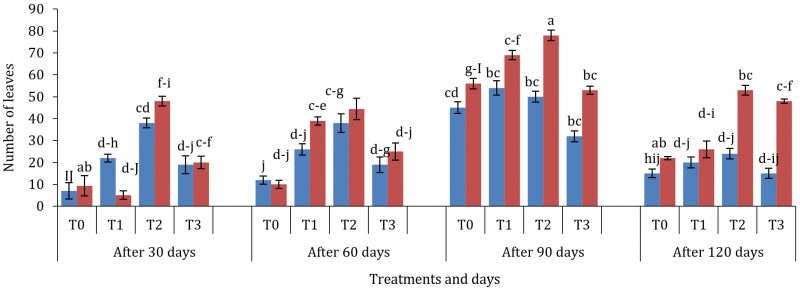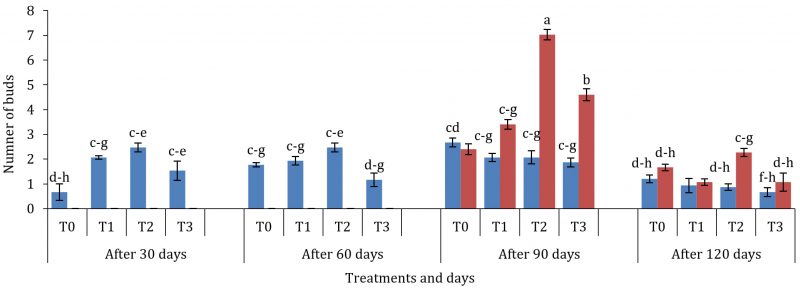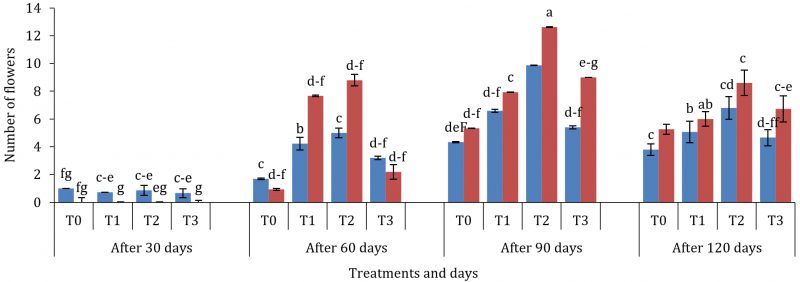
Copyright: © 2023 by the authors. This article is an open access article distributed under the terms and conditions of the Creative Commons Attribution 4.0 International License. J. Hortic. Sci. Technol. © 2023 Pakistan Society for Horticultural Science.
ABSTRACT
Marigold (Tagetes erecta), a member of the Asteraceae family, is widely cultivated for its ornamental and medicinal value. Native to the Americas, marigolds are important for their vibrant flowers, as they are used in landscaping, as cut flowers, and for various cultural purposes. The success of marigold cultivation heavily depends on the choice of potting media, as it affects plant growth and development. This research aimed to evaluate the impact of different potting media on the morphological attributes of Tagetes erecta, including stem length, leaf number, and flower production. Four treatments were used: control, leaf compost soil, sewage soil, and river soil. The study assessed the growth responses over 30, 60, 90, and 120 days. The results indicated that leaf compost soil significantly enhanced all measured growth parameters, supporting the role of organic-rich media in promoting plant health. Sewage soil also showed positive growth responses, although to a lesser extent. The control group exhibited the poorest growth, highlighting the importance of nutrient availability in potting media. These findings suggest that compost-based media improve marigold growth through better nutrient availability and moisture retention. Future research should explore optimal media combinations to enhance plant performance while addressing challenges like nutrient leaching and moisture fluctuations.
NTRODUCTION
The marigold, belonging to the Asteraceae family, has its origins primarily in Central and South America, particularly Mexico. This genus, Tagetes, encompasses around thirty-six species, with Tagetes patula and Tagetes erecta being the most widely cultivated for ornamental and commercial purposes (Kumar et al., 2018). Marigold (Tagetes erecta L.) is a versatile plant known for its ornamental, medicinal, and genetic research significance. It is widely cultivated for its vibrant flowers and is a subject of interest in various scientific studies due to its diverse applications. Marigold exhibits significant genetic diversity, which is crucial for breeding programs aimed at developing superior varieties. Traits such as canopy width, flower weight, and flower diameter show broad genetic diversity and high heritability, making them ideal for selection in breeding efforts. The plant’s genetic diversity is assessed through variance components and heritability values, with studies conducted on various genotypes revealing significant differences in morphological traits (Hou and Yang, 2011). Marigold flowers possess significant medicinal potential, with aqueous extracts showing antioxidant, anti-bacterial, anti-inflammatory, and anti-carcinogenic properties. Phytochemical analysis reveals the presence of flavonoids, phenols, alkaloids, and tannins, contributing to its strong antioxidant activity with an IC50 value of 50.77 ppm (Amabye et al., 2016). Marigolds are integral to various cultural practices, often used in religious ceremonies and social functions (Kumar et al., 2018). Their vibrant colours and long blooming periods enhance their popularity in gardens and floral arrangements (Tamut et al., 2019). The cultivation of marigold plants is significantly influenced by soil composition and management practices. Various studies highlight the importance of specific soil substrates, nutrient solutions, and the impact of irrigation methods on marigold growth and health. The following sections detail the optimal soil conditions and practices for marigold cultivation. The growth of marigolds can be significantly influenced by the type of growing media used, including sewerage soil, leaf soil, and river soil. Research indicates that the composition of these media affects various growth parameters and flowering characteristics of marigold plants. Below are key insights regarding the impact of these different soils on marigold cultivation. Treated sewage water (TSW) has been shown to enhance growth metrics such as plant height and flower production when combined with organic media like farmyard manure and cocopeat. The nutrient profile of TSW, which includes higher levels of nitrogen (N), phosphorus (P), and potassium (K), supports robust vegetative growth and flowering (Panj et al., 2014; Mann et al., 2023). While specific studies on leaves were not highlighted, organic matter from decomposed leaves can improve soil structure and nutrient availability, potentially benefiting marigold growth. The addition of organic materials generally enhances soil fertility, which is crucial for flowering plants like marigolds. River soil, particularly when contaminated, has been studied for its phytoremediation capabilities. Marigolds can thrive in such environments, effectively absorbing heavy metals, which indicates their resilience and adaptability (Gola et al., 2018; Biswojit et al., 2021). The growth performance in river soil can vary based on contamination levels, but marigolds have shown the potential to improve soil health through their growth. In contrast, while sewerage and river soils can provide essential nutrients and support growth, they may also pose risks of contamination (Sumathi et al., 2017). Therefore, careful management and treatment of these soils are necessary to ensure the health of marigold plants and the surrounding environment.
Marigold (Tagetes erecta L.) is a versatile plant valued for its ornamental and medicinal uses. Despite its adaptability, optimal cultivation practices, particularly in selecting suitable potting media, remain underexplored. The effects of various substrates, including organic, inorganic, and unconventional soils like treated sewage and river soil, on marigold’s growth and morphology need further investigation. Addressing these gaps is essential to enhance Marigold’s cultivation and environmental sustainability. Therefore, the current study aimed to evaluate the effects of different potting media on marigold’s growth and morphology.
MATERIALS AND METHODS
The experiment was conducted at the Botanical Garden of The Government Sadiq College Women University, Bahawalpur. A completely randomized design was employed for the study. French marigold (Tagetes patula) and American marigold (Tagetes erecta) seedlings were purchased from a local ornamental plant Nursery. A pot experiment was designed using different soil treatments: T0 (control), T1 (leaf compost soil), T2 (river soil), and T3 (sewage soil). The seedlings were transplanted into pots filled with different potting media. The slandered cultural practices, i.e. irrigation, hoeing and fertilizer dose. The following parameters were recorded i.e. stem length, leaf number, number of buds and number of flowers per plant. These growth parameters were recorded at three different intervals i.e. 30, 60, 90 and 120 days after transplantation. The data was recorded and arranged for further statistical analysis.
Statistical analysis
All the collected data were analysed using the analysis of variance technique. Means were separated using the least significant difference test at 5% probability. Graphs of the traits were constructed in Microsoft Excel Version 2024.
RESULTS
Impact of potting media on stem length
Figure 1 illustrates the stem length of marigold plants under treatments T0 (control), T1 (leaf compost soil), T2 (river soil), and T3 (sewage soil) over 30, 60, 90, and 120 days. Significant differences were observed for treatments, genotypes, and their interactions with time (p<0.05). After 30 days, Tagetes erecta (v2) showed the highest stem length under T2 (15.67 cm), followed by T3 (13.25 cm), with the lowest under T0 for both T. erecta (4.12 cm) and T. patula (v1, 3.87 cm). After 60 days, T. erecta had the highest length under T2 (22.34 cm), followed by T4 (18.76 cm), and the lowest under T0 (T. erecta 6.43 cm, T. patula 5.98 cm). After 90 days, T. erecta showed the highest stem length under T2 (29.45 cm), followed by T3 (25.67 cm), with the lowest under T0 (T. erecta 7.32 cm, T. patula 6.87 cm). After 120 days, T. erecta reached the highest stem length under T2 (34.12 cm), followed by T3 (29.67 cm), with the lowest under T0 (T. erecta 8.12 cm, T. patula 7.78 cm).Figure 1: Effect of different soil treatments on stem length of marigold varieties (Tagetes erecta and Tagetes patula).
Impact of potting media on number of leaves
Figure 2 shows the number of leaves in marigold plants under treatments T0 (control), T1 (sewage soil), T2 (leaf compost soil), and T3 (river soil) over 30, 60, 90, and 120 days. Significant differences were observed for treatments, genotypes, and their interactions with time (p<0.05). After 30 days, Tagetes erecta (v2) showed the highest number of leaves under T2 (50.34), followed by T1 (42.67), with the lowest under T0 for both T. erecta (15.21) and T. patula (v1, 13.45). After 60 days, T. erecta had the highest number of leaves under T2 (63.45), followed by T1 (56.78), and the lowest under T0 (T. erecta 18.67, T. patula 17.34). After 90 days, T. erecta showed the highest number of leaves under T2 (78.34), followed by T1 (70.21), with the lowest under T0 (T. erecta 20.43, T. patula 19.12). After 120 days, T. erecta reached the highest number of leaves under T2 (85.67), followed by T1 (75.43), with the lowest under T0 (T. erecta 23.56, T. patula 21.34).Figure 2: Effect of different soil treatments on the number of leaves of marigold varieties (Tagetes erecta and Tagetes patula).
Impact of potting media on number of buds
Figure 3 exhibits the number of buds in marigold plants under treatments T0 (control), T1 (sewage soil), T2 (leaf compost soil), and T3 (river soil) over 30, 60, 90, and 120 days. Significant differences were observed for treatments, genotypes, and their interactions with time (p<0.05). After 30 days, Tagetes erecta (v2) exhibited the highest number of buds under T2 (2.78), followed by T3 (2.56), with the lowest under T0 for both T. erecta (1.12) and T. patula (v1, 0.98). After 60 days, T. erecta had the highest number of buds under T2 (3.12), followed by T3 (2.89), with the lowest under T0 (T. erecta 1.34, T. patula 1.01). After 90 days, T. erecta showed the highest number of buds under T2 (7.34), followed by T1 (5.89), with the lowest under T0 (T. erecta 2.01, T. patula 1.78). After 120 days, T. erecta achieved the highest number of buds under T2 (4.56), followed by T1 (3.89), with the lowest under T0 (T. erecta 1.56, T. patula 1.23).Figure 3: Effect of different soil treatments on the number of buds marigold varieties (Tagetes erecta and Tagetes patula).
Impact of potting media on number of flowers
Figure 4 demonstrates the number of flowers in marigold plants under treatments T0 (control), T1 (sewage soil), T2 (leaf compost soil), and T3 (river soil) over 30, 60, 90, and 120 days. Significant differences were observed for treatments, genotypes, and their interactions with time (p<0.05). After 30 days, Tagetes erecta (v2) exhibited the highest number of flowers under T2 (2.34), followed by T3 (2.01), with the lowest under T0 for both T. erecta (0.67) and T. patula (v1, 0.45). After 60 udays, T. erecta had the highest number of flowers under T2 (9.34), followed by T1 (8.21), with the lowest under T0 (T. erecta 1.45, T. patula 1.21). After 90 days, T. erecta showed the highest number of flowers under T2 (13.45), followed by T1 (10.78), with the lowest under T0 (T. erecta 2.34, T. patula 2.01). After 120 days, T. erecta achieved the highest number of flowers under T2 (12.23), followed by T1 (10.89), with the lowest under T0 (T. erecta 3.56, T. patula 3.12).Figure 4: Effect of different soil treatments on the number of flowers of marigold varieties (Tagetes erecta and Tagetes patula).
DISCUSSION
The results of this study show that the morphological attributes of marigold plants, such as stem length, leaf number, and flower production, are significantly influenced by the type of potting media used. Plants grown in leaf compost soil (T2) consistently exhibited the best growth performance across all measured parameters. After 30, 60, 90, and 120 days, Tagetes erecta (v2) showed the highest stem length, leaf count, and flower production under T2, aligning with findings from previous research that organic-rich media, like compost, enhance plant growth by improving nutrient availability and water retention (Tsakaldimi and Ganatsas, 2016; Gruda, 2022). The superior growth in T2-treated plants can be attributed to the nutrient-rich composition of compost, which likely supports better root development and overall plant health.
Similarly, plants grown in sewage soil (T3) showed relatively good growth, with T. erecta reaching a stem length of 29.67 cm and producing a substantial number of leaves and flowers. While sewage soil was less effective than compost-based media, it still provided an improved environment compared to the control (T0). This supports earlier studies that suggest nutrient availability in sewage soil can positively influence plant morphology, though not to the same extent as leaf compost soil (Mohammadi-Ghehsareh, 2015). The control group (T0), which lacked enriched nutrients, consistently resulted in the lowest growth parameters across all time points. Both stem length and leaf number were significantly reduced in the control group compared to the other treatments. These findings are in line with literature that highlights the challenges faced by plants grown in non-amended soils, including limited nutrient availability and poor physical properties, which hinder growth (Mehmood et at., 2013; Tsakaldimi and Ganatsas, 2016; Bhat et al., 2021).
The positive effects of organic potting media on marigold morphology observed in this study confirm the value of compost-based media in promoting plant growth. However, while organic media provide substantial benefits, challenges such as nutrient leaching and inconsistent moisture levels need to be managed to ensure optimal plant development (Jabbar et al., 2018; Mohammadi-Ghehsareh, 2015; Sachin et al., 2020). Overall, this research supports the idea that compost-based potting media are effective in enhancing the growth of marigold plants, providing a richer environment that supports better morphology and reproductive success (Kumar and Chaudhary, 2018; Sardar et al., 2022).
CONCLUSION
This study highlights the significant impact of potting media on the morphological growth of Tagetes erecta. Leaf compost soil enhanced stem length, leaf number, and flower production, supporting previous research on the benefits of organic-rich media. Sewage soil also promoted growth but to a lesser extent, indicating its potential as an alternative medium. The control group exhibited the poorest results, emphasizing the importance of nutrient availability. These findings reinforce that compost-based media improve plant health by providing balanced nutrients and better water retention. However, challenges like nutrient leaching and moisture fluctuations need to be managed. Future research could focus on optimizing media combinations for even better growth outcomes.
Declaration of competing interests
The authors declare no conflict of interest.
Author contribution statement
Tahira Fatima: Project idea, Data taking, Analysis, Writeup, Revision of the draft. Ayesha Mahmood: Project idea, Data taking, Analysis, Writeup, Revision of the draft. Iram Naz: Project idea, Data taking, Analysis, Writeup, Revision of the draft.
Acknowledgments
The authors are deeply grateful to the Department of Botany, The Government Sadiq College Women University, Bahawalpur for providing the resources, guidance, and support necessary to successfully complete this work.
REFERENCES
Amabye, T.G., Bezabh, A.M., Mekonen, F. 2016. Phytochemical constituents and antioxidant activity of Delonix elata L. in flower extract. Journal of Analytical & Pharmaceutical Research, 2(1): 00006. [Google Scholar, CrossRef]
Bhat, R.A., Bhat, Z.A., Rafiq, S., Nazki, I.T., Khan, F.U., Neelofar, R.Z., Masoodi, N., Altaf, Q. and Rather, R.A. 2021. Influence of growing media on vegetative, floral and bulb parameters of crown lily (Fritillaria Imperialis L.). Acta Agriculturae Scandinavica, 5: 112-116. [Google Scholar, CrossRef]
Biswal, B., Satish, K.S., Singh, A., Patra, K. and Kumar, M. 2021. Evaluation of phytoremediation capability of French marigold (Tagetes patula) and African marigold (Tagetes erecta) under heavy metals contaminated soils. International Journal of Phytoremediation, 24(9): 945-954. [Abstract/FREE full text, PubMed, Google Scholar, CrossRef]
Gola, A.Q., Jakhro, M.I., Habib, M., Ahmed, S., Badini, M.A., Shahwani, M.W., Naseer, N.S. and Shah, S.I.A., 2018. Influence of various growing media on growth and flowering of zinnia (Zinnia elegans) Dreamland. Pure and Applied Biology, 7(3): 946-954. [Abstract/FREE full text, Google Scholar, CrossRef]
Gruda, N.S., 2022. Advances in soilless culture and growing media in today’s horticulture editorial. Agronomy, 12(11): 2773. [Abstract/FREE full text, Google Scholar, CrossRef]
Hou, J., Yang, G. 2011. Evaluation of growing medium composition on marigold (Tagetes erecta L.) seedling quality. Acta Horticulturae, 891: 237-240. [Abstract/FREE full text, Google Scholar, CrossRef]
Jabbar, A., Tehranifar, A., Shoor, M. and Nemati, S.H., 2018. Effect of different media on some growth, flowering and biochemical parameters of two cultivars of gladiolus (Gladiolus grandiflorus L.) under soilless conditions. Journal of ornamental Plants, 8: 205-215. [Abstract/FREE full text, Google Scholar]
Kumar, M. and Chaudhary, V., 2018. Effect of integrated sources of nutrients on growth, flowering, yield and soil quality of floricultural crops: a review. International Journal of Current Microbiology and Applied Sciences, 7(3): 2373-2404. [Google Scholar, CrossRef]
Kumar, R., Kumar, A. and Kumar, A. 2018. Effect of nutrients on growth, flowering and yield of african marigold (Tagetes erecta L.) cv. Pusa Narangi Gainda. International Journal of Current Microbiology and Applied Sciences, 7(6): 205-209. [Google Scholar, CrossRef]
Mann, G.S., Dubey, R.K., Singh, S., Deepika, R., Singh, D. and Kaur, N. 2023. Effect of growing media on growth and flowering of potted marigold (Tagetes erecta L.) irrigated with treated sewage water. Journal of Plant Nutrition, 5: 1-14. [Abstract/FREE full text, Google Scholar]
Mehmood, T., Ahmad, W., Ahmad, K.S., Shafi, J., Shehzad, M.A. and Sarwar, M.A. 2013. Comparative effect of different potting media on vegetative and reproductive growth of floral shower (Antirrhinum majus L.). Universal Journal of Plant Science, 1(3): 104-111. [Google Scholar, CrossRef]
Mohammadi-Ghehsareh, A. 2015. Effect of plant growth on some physical properties of potting culture media. International Journal of Recycling of Organic Waste in Agriculture, 4: 205-209. [Abstract/FREE full text, Google Scholar, CrossRef]
Panj, F.G., Kumari, S. and Parmar, P.B. 2014. Effect of growing media properties and its correlation study in gerbera production. The Bioscan, 9: 79-83. [Google Scholar]
Sachin, T.M., Thakur, N. and Sharma, P. 2020. Use of alternative growing media in ornamental plants. International Journal of Chemical Studies, 8(6): 188-194. [Google Scholar, CrossRef]
Sardar, H., Waqas, M., Naz, S., Ejaz, S., Ali, S. and Ahmad, R. 2022. Evaluation of different growing media based on agro-industrial waste materials for the morphological, biochemical and physiological characteristics of stevia. Cleaner Waste Systems, 3: 100038. [Abstract/FREE full text, Google Scholar, CrossRef]
Sumathi, T., Chawla, S.L., Patil, S. and Palagani, N. 2017. Effect of growing media and primary nutrients on postharvest life of cut flowers of anthurium vs Tropical. Journal of ornamental Horticulture, 20: 75-79. [Abstract/FREE full text, Google Scholar]
Tamut, O., Singh, K.P. and Panwar, S. 2019. Variations in quantitative and qualitative composition of essential oils from leaves and flowers of French marigold (Tagetes patula). International Journal of Current Microbiology and Applied Sciences, 8(7): 1037-1042. [Google Scholar, CrossRef]
Tsakaldimi, M. and Ganatsas, P. 2016. A synthesis of results on wastes as potting media substitutes for the production of native plant species. Reforesta, 1: 147-163. [Abstract/FREE full text, Google Scholar, CrossRef]
Potting media, morphology, organic media, growth promotion, nutrient availability.
* Corresponding author
a Department of Botany, Faculty of Science, The Government Sadiq College Women University, Bahawalpur, Pakistan
b Institute of Agro-Industry and Environment, The Islamia University of Bahawalpur, Pakistan
Email: faithymalik@gmail.com (T. Fatima), iramnaz4545@gmail.com (I. Naz)
This article does not contain any abbreviations to display here.
Received: 18 March 2023
Revised: 21 July 2023
Accepted: 15 August 2023
Published: 30 September 2023
How to Cite
| AMA |
Fatima T, Mehmood A, Naz I. Morphological responses of marigold (Tagetes erecta L.) to different potting media. J Hortic Sci Technol. 2023;6(3):31-35. doi:https://doi.org/10.46653/jhst23063031
|
| MLA |
Fatima, Tahira, et al. “Morphological Responses of Marigold (Tagetes Erecta L.) to Different Potting Media.” Journal of Horticultural Science & Technology, vol. 6, no. 3, Sept. 2023, pp. 31–35, https://doi.org/10.46653/jhst23063031.
|
| APA |
Fatima, T., Mehmood, A., & Naz, I. (2023). Morphological responses of marigold (Tagetes erecta L.) to different potting media. Journal of Horticultural Science & Technology, 6(3), 31–35. https://doi.org/10.46653/jhst23063031
|
Download Citation (RIGHT CLICK & “SAVE LINK AS”)
This article do not contain any supplementary data.




